Una de las variables que incide directamente en la propagación del virus Covid-19 es la frecuencia de contactos entre las personas. Sin embargo, en la actualidad no se cuenta de mediciones directas de esta cantidad, y por lo tanto no se dispone indicadores que reflejen tal interacción. En Chile, usualmente se relaciona la “movilidad” con la mencionada frecuencia de contactos, lo cual no es del todo acertado, pero en ausencia de mejores indicadores ésta puede darnos alguna información global.
En nuestro país se distinguen al menos tres indicadores de movilidad.
- Movilidad Google. Este indicador corresponde a la variación porcentual del número de visitas de personas a distintos lugares mas frecuentados de la ciudad y se obtiene a partir de las conexiones de los usuarios a google mediante GPS.
- Movilidad en el transporte público. Corresponde al número de viajes entre comunas y se determina mediante el número de tarjetas BIP utilizadas diariamente en cada comuna: se tiene la comuna de inicio del viaje y una estimación del lugar de bajada mediante el software ADATRAP del DTPM.
- Movilidad de cruces de antenas de comunicación de celulares. Son datos suministrados por el Instituto Data Science de la UDD en base a datos de la empresa Movistar. Se registran el número de celulares conectados a las antenas y los cambios que experimentan estos celulares en la red de antenas, dependiendo de sus cambios de posición.
Movilidad Google
De la figura se desprenden los cambios que ha experimentado este indicador desde principios de la pandemia. Se observa un decrecimiento notorio que coincide con el cierre de colegios a mediados de Marzo. Y un decrecimiento menos notorio al inicio de cuarentenas totales aplicada el día 15 de Mayo. Posteriormente, se observa un repunte en la fecha donde comenzaron las liberaciones de cuarentenas a mediados de Julio e inicio del plan “Paso a Paso”. Cabe mencionar también, la correlación inversa que existe con la movilidad en las zonas residenciales durante todos estos eventos.
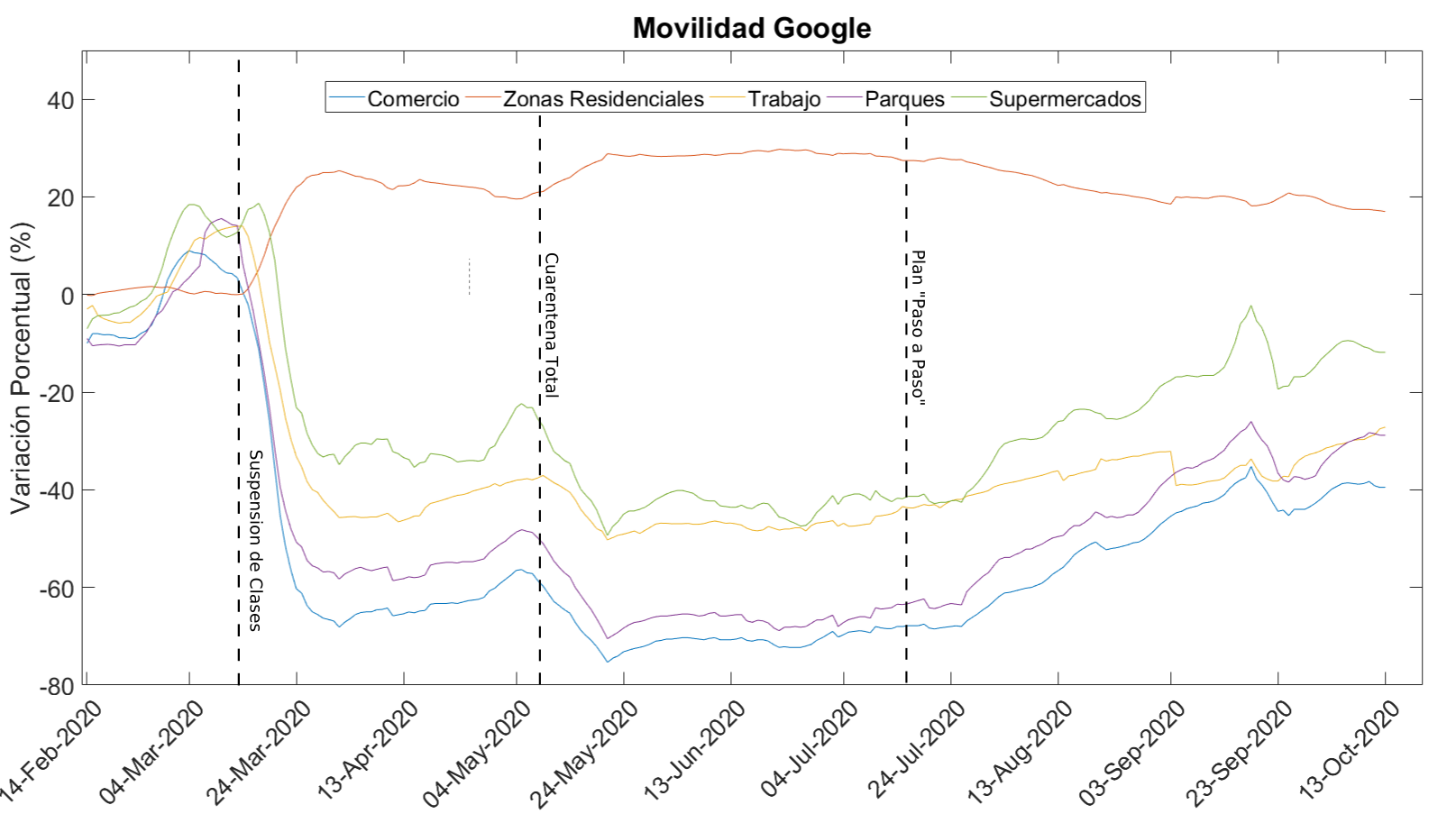
Figura 1: Diferencia porcentual de movilidad en distintos sectores de la RM respecto a Febrero-2020. Las líneas segmentadas verticales señalan la fecha en la que fueran aplicadas las diferentes medidas propuestas por el gobierno. Fuente: COVID-19 Community Mobility Reports – Google, www.google.com/covid19/mobility/
Movilidad del transporte público.
En las figuras 2 y figura 3 se observa el número de viajes por comuna para la semana del 2 al 6 de marzo, antes de los cierres de colegios y en la semana del 11 al 15 de Mayo, durante las cuarentenas dinámicas y antes de decretar la cuarentena total. Se dispuso cada gráfica en el orden estipulado en el mapa, (subgráfico de la figura 2) con el fin de observar la interacción de las comunas con sus vecinas, como es el caso de Santiago, donde se observa una mayor actividad de transporte con sus comunas vecinas como Ñuñoa y Estación Central.
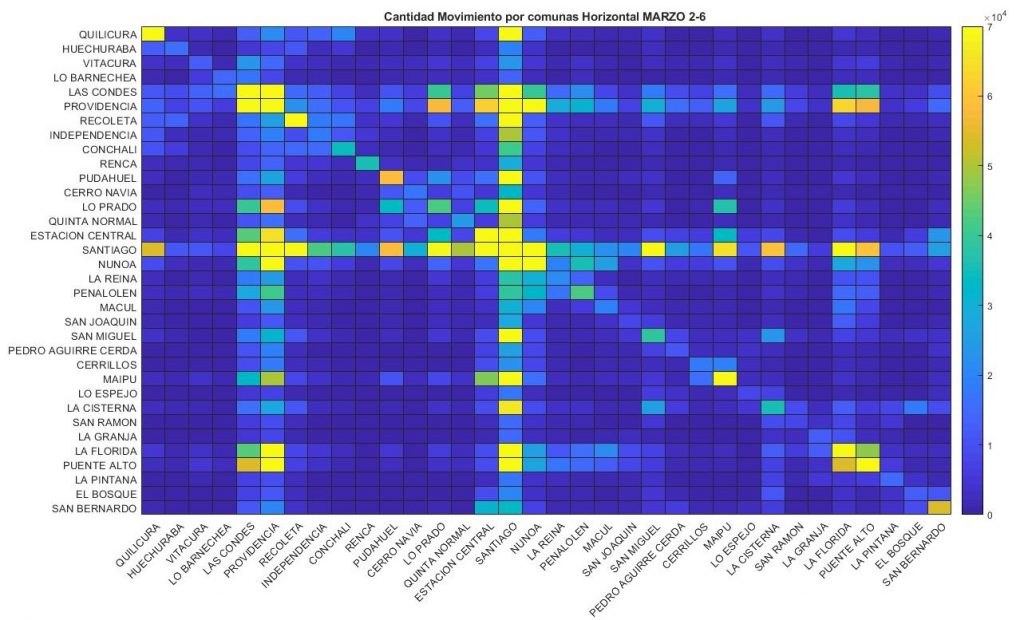
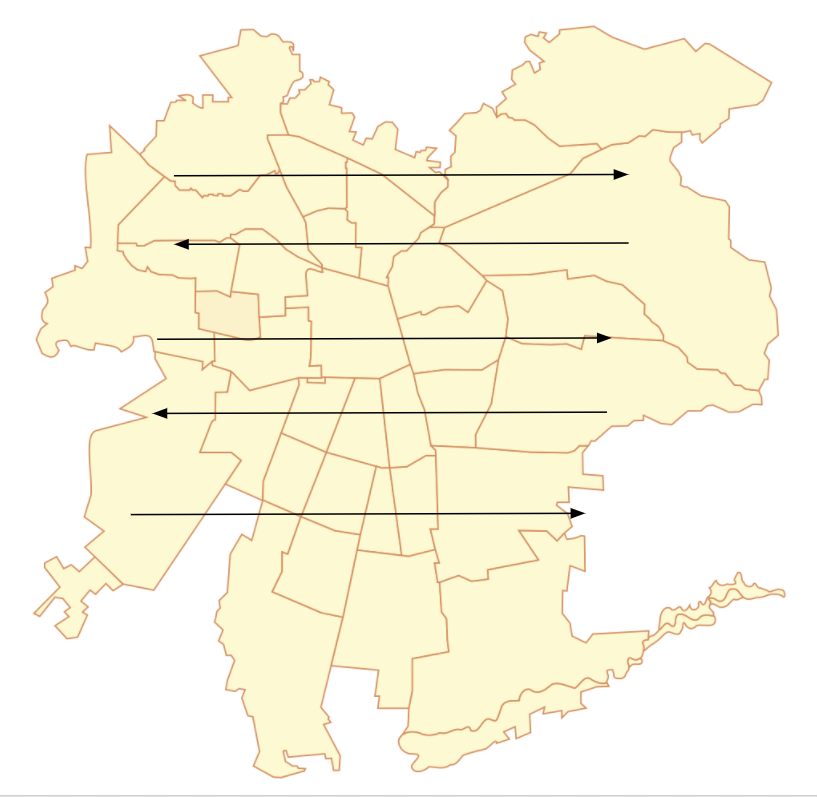
Figura 2: Cantidad de transacciones Bip en transporte público durante el 2 al 6 de Marzo 2020. Subfigura : Mapa de Santiago con indicaciones de orden de comunas en Figura 2. Fuente: Mesa de Datos COVID-19 liderada por el Ministerio de Ciencia, Tecnología, Conocimiento e Innovación. https://github.com/MinCiencia/Datos-COVID19.
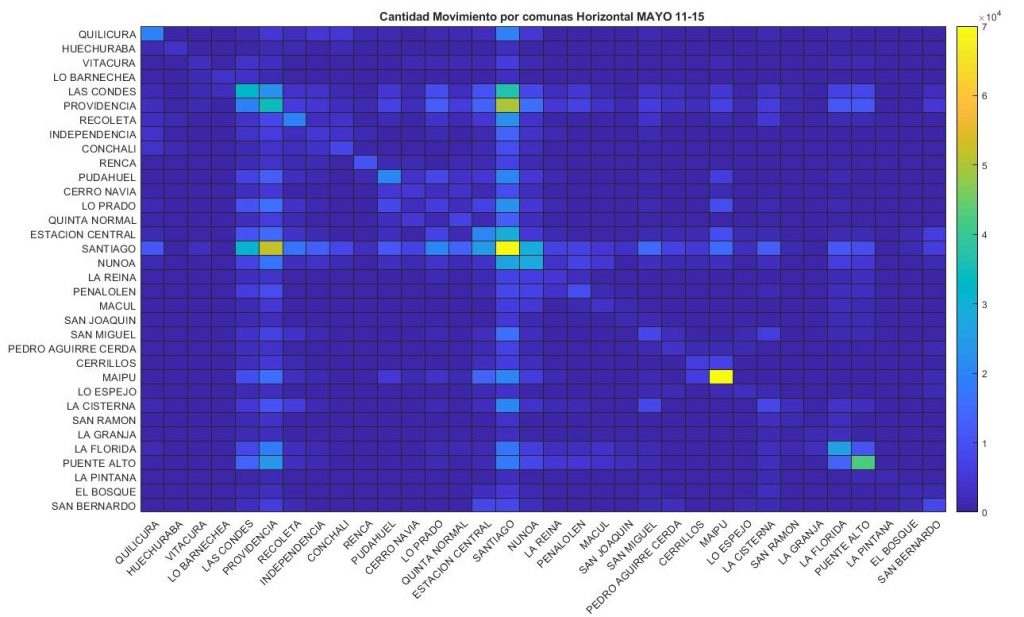
Figura 3: Cantidad de transacciones Bip en transporte público durante el 11 al 15 de Mayo 2020. Fuente: Mesa de Datos COVID-19 liderada por el Ministerio de Ciencia, Tecnología, Conocimiento e Innovación. https://github.com/MinCiencia/Datos-COVID19.
Al comparar las figuras 2 y figura 3, observamos una disminución en la cantidad de transacciones Bip en esas 9 semanas de diferencia, provocada por la implementación de las cuarentenas dinámicas y la suspensión de clases en la región. Desgraciadamente no se disponen de datos mas actuales para un posterior análisis.
Movilidad de cruces de antenas de comunicación de celulares.
El índice de movilidad total nos muestra el número de cruces de antenas por celular separados por cruce intra-comunales (o movilidad interna), extra-comunales (o movilidad externa) y la suma de ambas (o movilidad total).
Los índices de movilidad total de distintas comunas de Santiago, muestran una gran disminución de movilidad a mediados de Marzo, que coincide con el cierre de colegios y comienzo de las cuarentenas dinámicas, posterior se observa una pequeña disminución, aunque menos significativa, disminución de la movilidad cerca del 15 de Mayo provocada por el inicio de la cuarentena total en la región. Desde esa fecha, los índices de movilidad de las comunas han ido en aumento producto de liberaciones graduales de cuarentenas en las distintas comunas. Se observa que la mayoría de las comunas han recuperado su actividad muy cercana a sus niveles pre-pandemia.
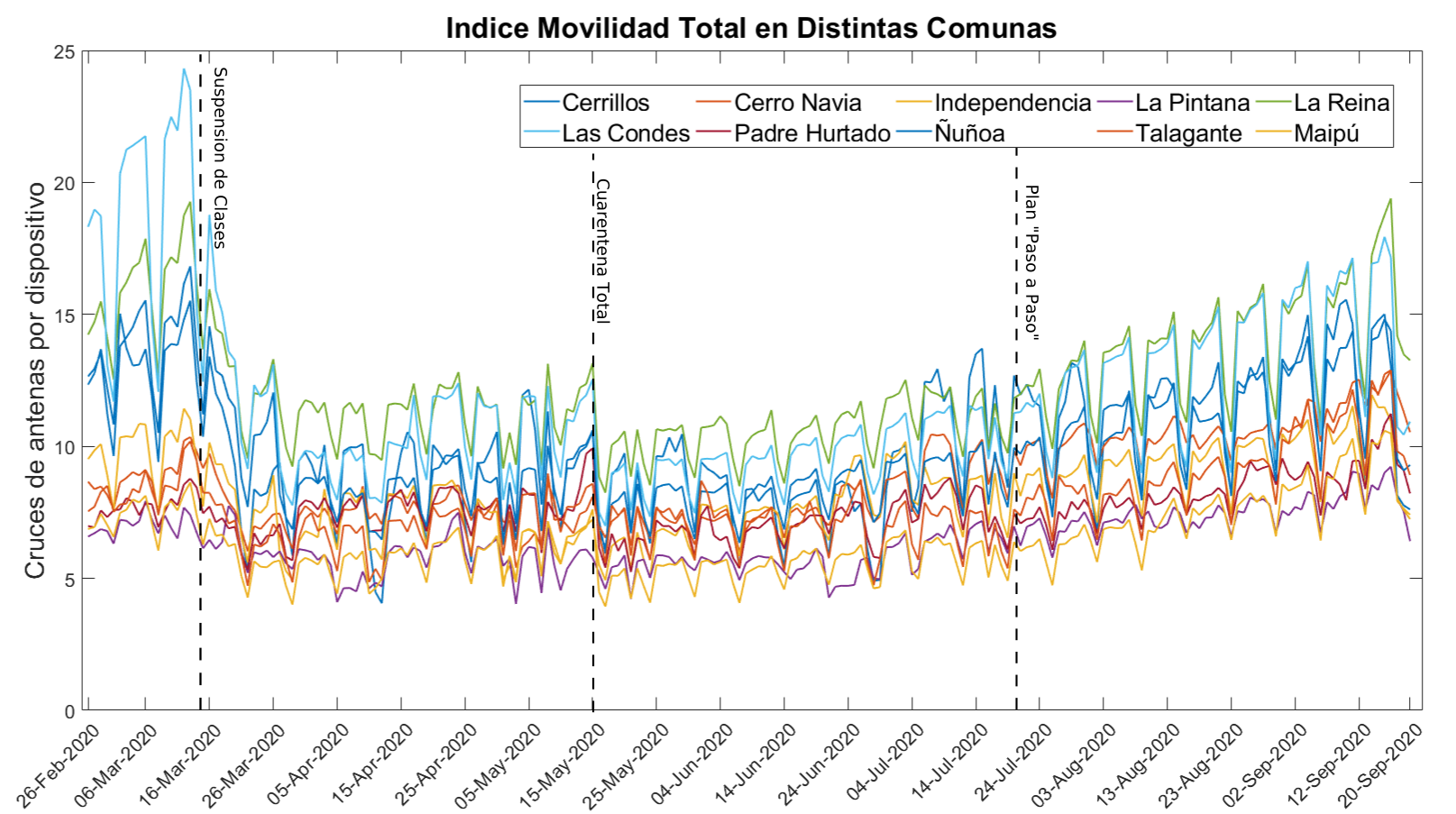
Figura 4: Cruce total de antenas por dispositivo en distintas comunas de la RM desde finales de Febrero 2020, Fuente: Data Science, Movilidad y COVID-19. http://datascience.udd.cl/movilidad/
Es posible realizar un breve análisis a los datos de cruce de antenas proporcionados por UDD. Procedemos de la siguiente manera.
- Se obtuvieron los datos de Índice de Movilidad suministrados por el Instituto de Data Science de la UDD (http://datascience.udd.cl/movilidad/). este indice corresponde al numero de celulares interactuando con la red de telefonía que registra la conexión a una antena y el tiempo en el que ocurrió, con ello se puede determinar los cambios de conexión del dispositivo entre antenas. Este valor de conexiones se normaliza por el número total de dispositivos de la comuna, obteniendo el índice de movilidad suministrado por la UDD.
- De la Mesa de Datos COVID-19 liderada por el Ministerio de Ciencia, Tecnología, Conocimiento e Innovación (https://github.com/MinCiencia/Datos-COVID19), se obtuvieron los datos de Población total y territorio en metros cuadrados de cada comuna.
- Mediante el portal informativo del SUBTEL junto con la “ley de Torres” (http://antenas.subtel.cl/LeyDeTorres/informacion) se obtuvieron el numero total de antenas por comuna. Con este valor se determinó la distancia promedio entre antenas por comuna.
- Se confeccionó una lista del número de supermercados por comuna. Con este dato se determinó la distancia promedio entre supermercados de la comuna, filtrando las comunas con menos de 2 supermercados.
- Se definió un nuevo indicador que corresponde a la cifra total de cruces de celulares de antenas por dispositivo multiplicado por la distancia promedio antenas, lo que corresponde a la distancia promedio recorrida por un celular en la comuna.
- Se separaron los datos de IMDR por mes y se determinó el promedio mensual de cada comuna.
Se observó que el IMDR correlaciona de manera aceptable con la distancia entre supermercados de las comunas. En efecto, en comunas con distancia entre supermercados pequeñas, los dispositivos recorren menos distancias, mientras que, en comunas de gran extensión y menor densidad de supermercados, estas distancias recorridas son mayores. Existe una correlación lineal aceptable de los datos sustentando lo dicho. Con el fin de analizar la evolución mensual del IMDR se determina el coeficiente de correlación, es decir, la pendiente de la grafica IMDR vs distancia entre supermercados. Llamaremos a este coeficiente MDR, cuyo aumento es directamente proporcional al incremento de la distancia recorrida de manera global en todas las comunas.
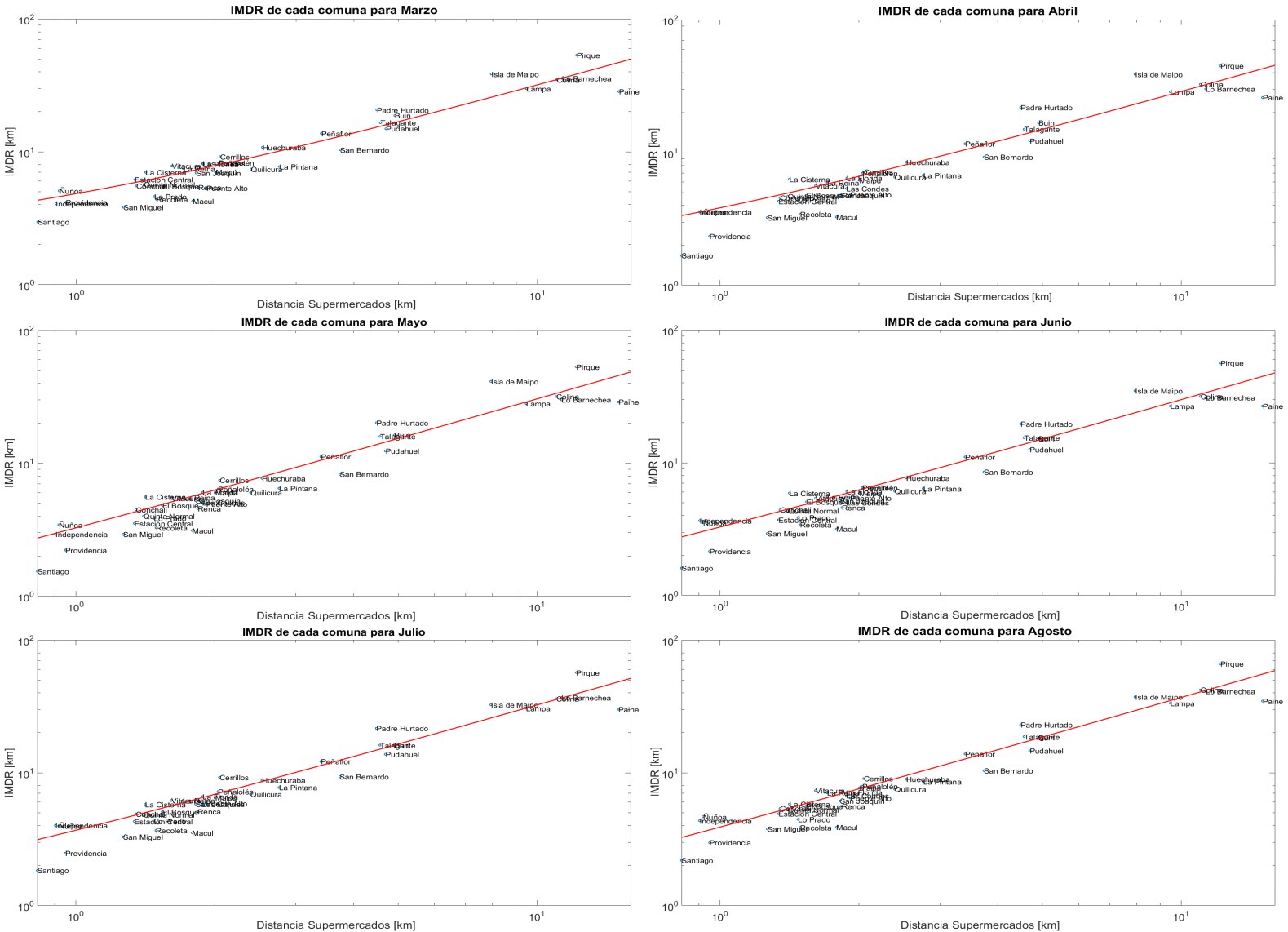
Figura 5: Promedio de distancia comunal recorrida por dispositivo, IMDR, en función de la distancia entre supermercados, con su línea de tendencia correspondiente y los valores etiquetados por comuna en cada uno de los gráficos, cada sub gráfico representa un mes de estudio
Finalmente, se analizan las pendientes, MDR, de las curvas IMDR vs distancia a supermercados, semanalmente desde el 26 de Febrero (figura 6). La variación relativa de esta pendiente refleja el aumento de distancia recorrida en todas las comunas. Se observa que la movilidad durante el periodo de las cuarentenas voluntarias de Marzo-Abril provocó una disminución significativa de esta pendiente, lo mismo para finales de Mayo y principios de Junio, efecto de la cuarentena total aplicada el día 15 de Mayo. Posterior a esa fecha y luego de la implementación del plan “Paso a Paso“ la movilidad en las comunas ha ido en aumento, al punto de superar la movilidad observada en el mes de Marzo. Cabe notar que un aumento en MDR del 25%, refleja un aumento igual (promedio) de IMDR en todas las comunas.
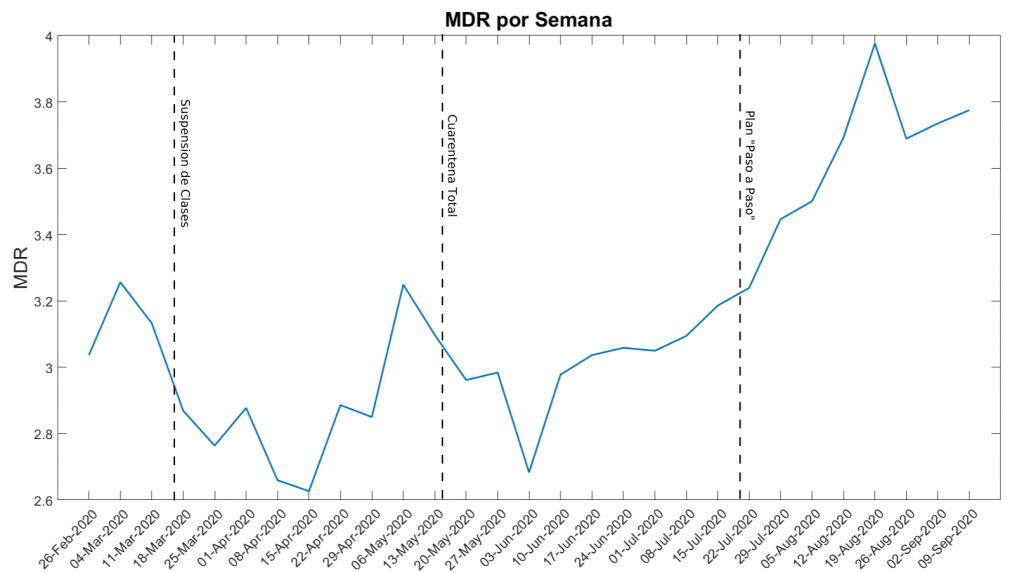
Figura 6: Evolución temporal de las pendientes, MDR, obtenidas de las curvas IMTA vs distancia supermercado para cada semana.
